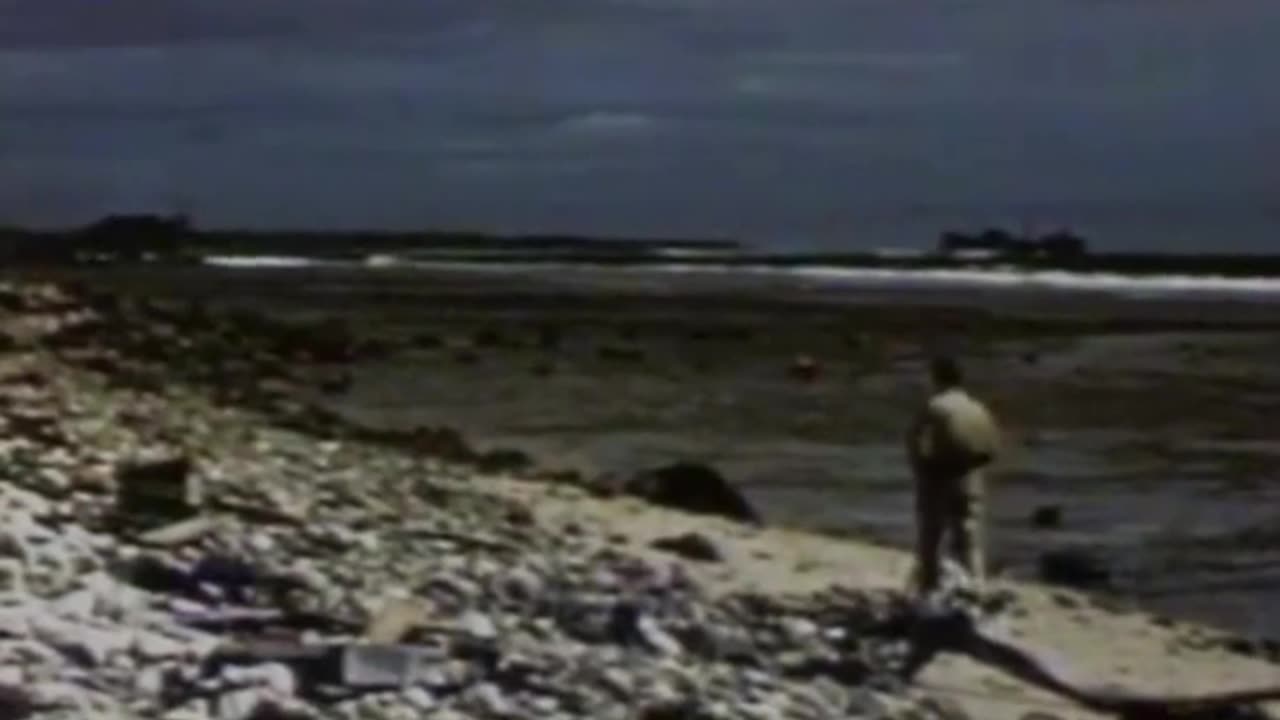Premium Only Content

Operation Ivy (1952)
Operation Ivy was the eighth series of American nuclear tests, coming after Tumbler-Snapper and before Upshot–Knothole. The two explosions were staged in late 1952 at Enewetak Atoll in the Pacific Proving Ground in the Marshall Islands.
Background
The Operation Ivy test series was the first to involve a hydrogen bomb rather than an atomic bomb, further to the order of President Harry S. Truman made on January 31, 1950 that the US should continue research into all forms of nuclear weapons. The bombs were prepared by the US Atomic Energy Commission and Defense Department aboard naval vessels, and were capable of being detonated remotely from the control ship Estes.[1]
Tests
Mike
The first Ivy shot, codenamed Mike, was the first successful full-scale test of a multi-megaton thermonuclear weapon ("hydrogen bomb") using the Teller-Ulam design. Unlike later thermonuclear weapons, Mike used deuterium as its fusion fuel, maintained as a liquid by an expensive and cumbersome cryogenic system. The bomb was launched on November 1, 1952 and detonated on Elugelab Island yielding 10.4 megatons, almost 500 times the yield of the bomb dropped on Nagasaki, resulting in the total vaporization of the island. Eight megatons of the yield was from fast fission of the uranium tamper, creating massive amounts of radioactive fallout. The detonation left an underwater crater 6,240 ft (1.9 km) wide and 164 ft (50 m) deep where Elugelab Island had been. Following this successful test, the Mike design was weaponized as the EC-16, but it was quickly abandoned for solid-fueled designs after the success of the Castle Bravo shot.
The outcome of the test was reported to incoming president Eisenhower by Atomic Energy Commission Chairman, Gordon Dean, as follows: “The island of Elugelab is missing!”[citation needed]
Sampling mission
Four USAF F-84G Thunderjets equipped with filters were flown through the mushroom cloud's stem to collect radiochemical samples for analysis. "Red Flight" Leader Virgil K. Meroney of the nascent 1211th Test Squadron flew into the stem of the explosion first. In five minutes, he had gathered all the samples he could, and exited. Jimmy Priestly Robinson, age 28,[2][3][4] a captain with the 561st Fighter-Day Squadron, was lost near the end of his mission. After re-emerging from the cloud, both he and his wingman, pilot Captain Bob Hagan, encountered difficulties picking up rendezvous and runway navigational beacons due to "electromagnetic after effects" of the detonation.[3] Robinson hit an area of severe turbulence, spinning out and barely retaining consciousness. He regained control of his plane at 20,000 feet, but the electromagnetic storm had disrupted his instruments. In rain and poor visibility, without working instruments, Hagan and Robinson were unable to find the KB-29 tanker aircraft to refuel.[2][5]: 96 By the time they were successful in finding the signal, they were dangerously low on fuel, and before reaching the runway on Enewetak, both had depleted their reserves. While Hagan was able to glide and made an extraordinary successful dead-stick landing on the runway, Robinson was instead too far out to follow the same path and therefore attempted to land on water.[3] Robinson's jet crashed and sank 3.5 miles short of the island.[2][4][3] Robinson's plane flipped and his body was never found.[2] Approximately a year after his disappearance, Robinson was awarded a posthumous Distinguished Flying Cross for his service.[6][3] In 2002, a memorial stone at Virginia’s Arlington National Cemetery was erected.
As a result of the above collection of samples from the explosion by U.S. Air Force pilots, scientists found traces of the isotopes plutonium-246 and plutonium-244, and confirmed the existence of the predicted but undiscovered elements einsteinium and fermium.[2]
King
The second test, King, fired the highest-yield (500 kilotons) nuclear fission (A-bomb) weapon to date using only nuclear fission (no fusion nor fusion boosting). This test used an unretarded free-fall bomb from a B-36 bomber. The bomber suffered minor heat and blast damage and safely returned to base. This "Super Oralloy Bomb" was intended as a backup to the earlier "Mike" test, if the fusion weapon had failed. King yielded 540 kilotons,[7] 25 times more powerful than the Fat Man weapon.
Summary
See also: List of nuclear weapons tests of the United States
United States' Ivy series tests and detonations Name [note 1] Date time (UT) Local time zone[note 2][8] Location[note 3] Elevation + height [note 4] Delivery,[note 5]
Purpose [note 6] Device[note 7] Yield[note 8] Fallout[note 9] References Notes
Mike October 31, 1952 19:14:59.4 MHT (11 hrs) Elugelab (Flora), Enewetak Atoll 11.66573°N 162.18928°E 2 m (6 ft 7 in) + 8 m (26 ft) dry surface,
weapons development "Sausage" w/ TX-5 primary 10.4 Mt [9][10][11][12] Megaton ("M" as in Mike) device. First true experimental H-bomb, used cryogenic deuterium; became TX-16 weapon. Elugelab completely cratered.
King November 15, 1952 23:30:00.0 MHT (11 hrs) Runit (Yvonne), Enewetak Atoll 11.55878°N 162.34541°E 0 + 450 m (1,480 ft) free air drop,
weapons development Mk-18F SOB 540 kt [9][10][11][12] Kiloton ("K" as in King) device. Aka Super oralloy bomb (SOB), used 4 critical masses of U235. Largest pure fission device; also tested chain safety device.
The US, France and Great Britain have code-named their test events, while the USSR and China did not, and therefore have only test numbers (with some exceptions – Soviet peaceful explosions were named). Word translations into English in parentheses unless the name is a proper noun. A dash followed by a number indicates a member of a salvo event. The US also sometimes named the individual explosions in such a salvo test, which results in "name1 – 1(with name2)". If test is canceled or aborted, then the row data like date and location discloses the intended plans, where known.
To convert the UT time into standard local, add the number of hours in parentheses to the UT time; for local daylight saving time, add one additional hour. If the result is earlier than 00:00, add 24 hours and subtract 1 from the day; if it is 24:00 or later, subtract 24 hours and add 1 to the day. Historical time zone data obtained from the IANA time zone database.
Rough place name and a latitude/longitude reference; for rocket-carried tests, the launch location is specified before the detonation location, if known. Some locations are extremely accurate; others (like airdrops and space blasts) may be quite inaccurate. "~" indicates a likely pro-forma rough location, shared with other tests in that same area.
Elevation is the ground level at the point directly below the explosion relative to sea level; height is the additional distance added or subtracted by tower, balloon, shaft, tunnel, air drop or other contrivance. For rocket bursts the ground level is "N/A". In some cases it is not clear if the height is absolute or relative to ground, for example, Plumbbob/John. No number or units indicates the value is unknown, while "0" means zero. Sorting on this column is by elevation and height added together.
Atmospheric, airdrop, balloon, gun, cruise missile, rocket, surface, tower, and barge are all disallowed by the Partial Nuclear Test Ban Treaty. Sealed shaft and tunnel are underground, and remained useful under the PTBT. Intentional cratering tests are borderline; they occurred under the treaty, were sometimes protested, and generally overlooked if the test was declared to be a peaceful use.
Include weapons development, weapon effects, safety test, transport safety test, war, science, joint verification and industrial/peaceful, which may be further broken down.
Designations for test items where known, "?" indicates some uncertainty about the preceding value, nicknames for particular devices in quotes. This category of information is often not officially disclosed.
Estimated energy yield in tons, kilotons, and megatons. A ton of TNT equivalent is defined as 4.184 gigajoules (1 gigacalorie).
Radioactive emission to the atmosphere aside from prompt neutrons, where known. The measured species is only iodine-131 if mentioned, otherwise it is all species. No entry means unknown, probably none if underground and "all" if not; otherwise notation for whether measured on the site only or off the site, where known, and the measured amount of radioactivity released.
Gallery
Mike mushroom cloud.
Mike mushroom cloud.
Nuclear fallout map of Mike test.
Nuclear fallout map of Mike test.
Warehouse building (shot cab) that housed the Mike device.
Warehouse building (shot cab) that housed the Mike device.
Cylindrical Mike device (left) connected to measuring instrumentation (right).
Cylindrical Mike device (left) connected to measuring instrumentation (right).
King's fireball and subsequent mushroom cloud from sea-level view.
King's fireball and subsequent mushroom cloud from sea-level view.
King mushroom cloud.
King mushroom cloud.
References
The Island is Missing!, article from the U.S. Army Heritage and Education Center
Chapman, Kit (January 14, 2020). "Element Hunting in a Nuclear Storm". Distillations. Science History Institute. Retrieved January 14, 2020.
Wolverton, Mark (2009). "Into the Mushroom Cloud Most pilots would head away from a thermonuclear explosion". Air & Space Magazine. Smithsonian (August). Retrieved January 9, 2020.
"F-84G-5-RE Thunderjet Serial Number 51-1040". Pacific Wrecks. Retrieved January 9, 2020.
Gladeck, F. R.; Hallowell, J. H.; Martin, E. J.; McMullan, F. W.; Miller, R. H.; et al. (1 December 1982). OPERATION IVY: 1952 (pdf) (Technical report). Washington, D.C.: Defense Nuclear Agency. DNA 6036F. Archived (PDF) from the original on 22 August 2021. Retrieved 10 November 2021.
Department of the Army General Orders # 49 dated 9 June 1953 pp. 5–6
LA 7833-MS https://fas.org/sgp/othergov/doe/lanl/lib-www/la-pubs/00193930.pdf
"Time Zone Historical Database". iana.com. Retrieved March 8, 2014.
Sublette, Carey, Nuclear Weapons Archive, retrieved January 6, 2014
Hansen, Chuck (1995), The Swords of Armageddon, Vol. 8, Sunnyvale, CA: Chukelea Publications, ISBN 978-0-9791915-1-0
United States Nuclear Tests: July 1945 through September 1992 (PDF) (DOE/NV-209 REV15), Las Vegas, NV: Department of Energy, Nevada Operations Office, December 1, 2000, archived from the original (PDF) on June 15, 2010, retrieved December 18, 2013
Yang, Xiaoping; North, Robert; Romney, Carl (August 2000), CMR Nuclear Explosion Database (Revision 3), SMDC Monitoring Research
-
 4:19:58
4:19:58
SynthTrax & DJ Cheezus Livestreams
1 day agoFriday Night Synthwave 80s 90s Electronica and more DJ MIX Livestream BLACKLIGHT Edition
85.6K6 -
 5:06:26
5:06:26
VapinGamers
9 hours ago $1.95 earned🎮🔥 Fortnite/Farlight 84/COD - Maybe Dubs, Maybe Losses, Always Fun! - !upgrade
25.5K1 -
 4:03:01
4:03:01
TheNateVibez
9 hours agoGood Times & Friday Vibes✌ - Fraggin💥- ArmyVet🫡
40.3K2 -
 4:28:12
4:28:12
KataJade
10 hours agoHappy Apex Friday
27.6K1 -
 5:03:59
5:03:59
The tooth entertainment
7 hours agoGears Of War Judgment Livestream lets get to 300 followers #GamingOnRumble
43.2K1 -
 6:49:22
6:49:22
xBuRnTx
11 hours agoHappy Friday Everyone!
31.3K2 -
 2:34:48
2:34:48
Laura Loomer
10 hours agoEP112: MS-13 EVICTED By President Trump
70.1K45 -
 2:53:28
2:53:28
Toolman Tim
8 hours agoCommunity Gaming Night!! | Among Us
37.4K3 -
 2:34:47
2:34:47
GamerGril
9 hours agoMost Dangerous Gril This Side Of The Mississippi
29.5K3 -
 3:44:43
3:44:43
ZWOGs
9 hours ago🔴LIVE IN 1440p! - FiveM Fridays!! GTAV RP!! | Dwindle Digby | - Come Hang Out!
22.8K1